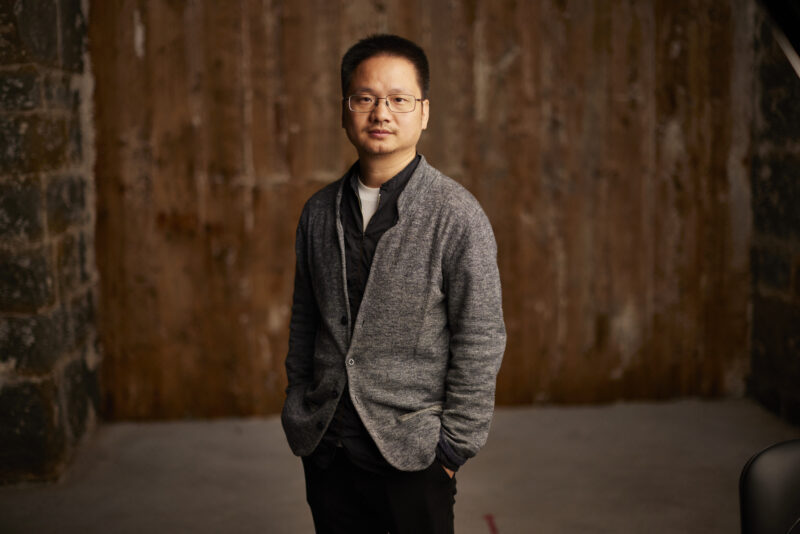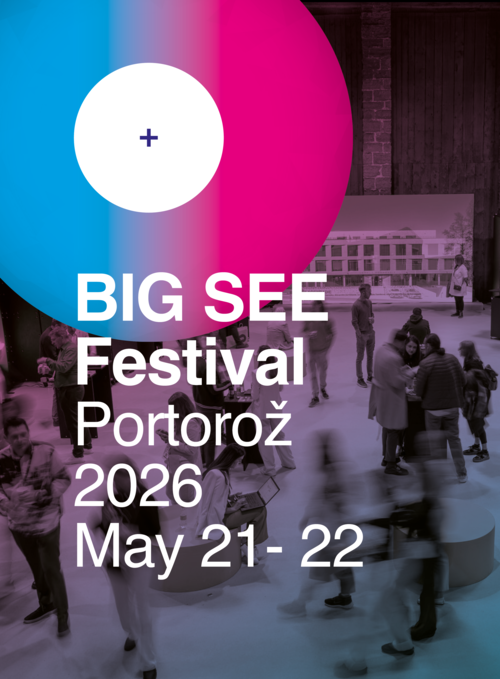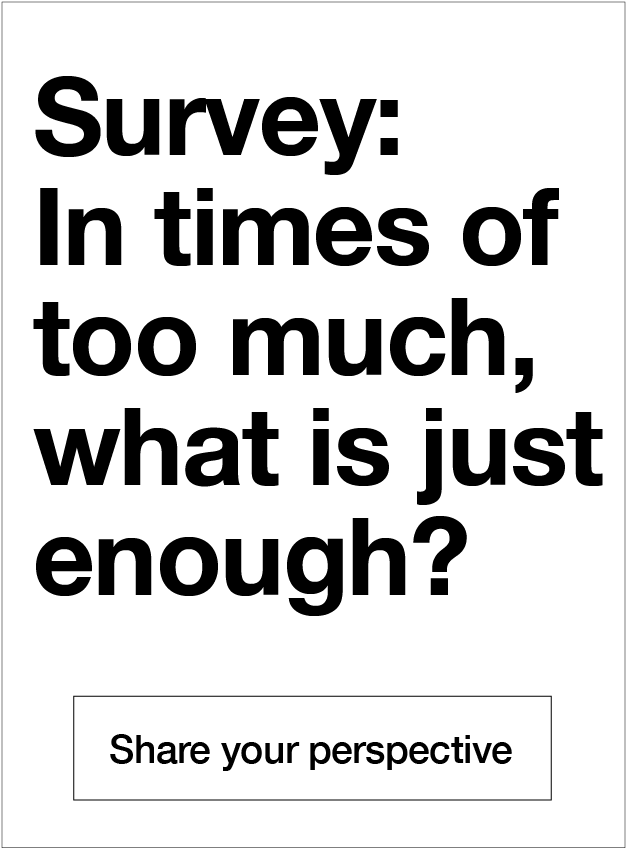During the BIG Architecture 2025 event in Portorož, Slovenian architect Miha Dešman—Dean and full professor at the Faculty of Architecture, University of Ljubljana—and Huang Huaihai, Deputy Chief Architect at China Southwest Architectural Design and Research Institute Corp. Ltd. (CSWADI), engaged in an in-depth discussion as part of the BIG SEE Talks series. Their exchange touched on the cultural, ethical, and professional dimensions of architecture, from vernacular heritage and architectural education to global development trends and the evolving role of the architect in contemporary society.
You can watch the full video of the conversation here or read the transcript below.

Miha Dešman: Nice to meet you here in Portorož in Slovenia. I think first we should agree about what we would be speaking. My proposal is that we speak about differences between small country as is Slovenia and the big country as is China.
I’m very interested about China, about China’s architecture, about China’s culture, about situation which is found in China, also about mental state there, how you think about future, how you think about past, how you think about current situation, about problems in the world of today, and maybe you are interested in Slovenia, in a small country.
Huang Huaihai: It’s my honor to have this opportunity to communicate with you, Mr. Dešman. This is my first time coming to Slovenia. It seems small, but quite beautiful. Talking about architecture, I think architects are working to find limited solutions in a very complex environment.
For me, architecture is something like a programming challenge. Everyone has to deal with certain environmental circumstances, and we can learn from each other.
China is quite big, and I know its scale and population might seem crazy to you.
Miha Dešman: We know more about Japan than about China. It is a fact that we know Japanese writers or Japanese architects better, like Sejima or Kengo Kuma, who also visit us quite often. We know Japanese movies, and so we think we understand their mentality and history. With China, I am more uncertain. I don’t really know how China is.
I remember the historical relations between Europe and China were difficult. I still remember the tragedies of the 19th century, like the Opium Wars, which we learned in school were part of European colonialism and expansionism by the British Empire, France, and other European countries who waged violent wars in China.
Huang Huaihai: Yes, for China, that was nearly 100 years from the middle of the 19th century to the founding of the People’s Republic of China. Japan also invaded China for eight years. Due to political reasons, few foreigners could come to China and know details about it. But now more and more foreigners are coming to China and learning about it, and China’s economic size and power are growing in the international world.
It’s time to renew our understanding of each other. Talking about architecture, Japanese architecture is deeply influenced by China. In East Asia, traditional architecture used timber. Around 100 years ago, the traditional way of using timber in construction ceased, and we introduced Western modern architecture.
Miha Dešman: In Europe during the 18th century, there was a mode of fascination with China. People traveled there, trade was established, and after the Baroque period, during Classicism in the 18th and early 19th centuries, Chinese sources like pagodas became very popular. There were gardens in London and France that tried to incorporate Chinese architectural elements.
Huang Huaihai: China has the longest continuing culture and political system.
Miha Dešman: Yes, I think this is important, also for architecture.
Huang Huaihai: When I was a student beginning to study architecture, we had to learn Western architectural history. We read about Greek, Roman, and United States styles, but at that time, the images were not clear to us since we hadn’t been to Europe. After traveling more, I began to feel that the world is very diverse.
Miha Dešman: In Europe, there were many revolutions in architectural language. The last big revolution was modernism, perhaps personified by Le Corbusier. Is it now the time of modernism in China, or are you continuing a thousand-year tradition? Are you changing everything now, or are you still maintaining tradition?
Huang Huaihai: We are continuing, but we are trying to find new ways. China reopened around 1990, the same time Slovenia was established. At that time, few Chinese people had traveled abroad. When we received information, we could only read foreign architecture magazines in our faculty library. Students were fascinated with modernism and post-modernism. We studied Le Corbusier, Tadao Ando, and other international architects.
Miha Dešman: Work has become global. Slovenian architecture is no longer so connected with roots or tradition. It’s more internationally comparable and inspired, but there are still some specifics. I believe that in China, as in Slovenia, vernacular tradition is very important for contemporary architecture.
Huang Huaihai: Vernacular tradition is quite important. In mega cities, you see skyscrapers and boxes, but when you go to villages, you can still find diversity and abundance. You can learn from vernacular architecture. When I finished my master’s diploma studying vernacular construction, I discovered how local people use appropriate technology with limited budgets to create human-controlled environments.
Vernacular tradition is quite important. In mega cities, you see skyscrapers and boxes, but when you go to villages, you can still find diversity and abundance. You can learn from vernacular architecture. When I finished my master’s diploma studying vernacular construction, I discovered how local people use appropriate technology with limited budgets to create human-controlled environments.
Huang Huaihai

Miha Dešman: If we compare Slovenia, our country, I could speak about the same logic as you have spoken. Also here, people helped each other. We have vernacular traditions in basically three different regions with three different materials. One is the Alpine world, where wood is the main material, with elaborate wooden frame construction. The second region is Mediterranean, where stone is the main traditional material, and the third is the Pannonian plane with clay and brick.
Huang Huaihai: I think the way Kenneth Frampton invented critical regionalism will still work, and we need that. Not every building will be high-tech, and architecture is not only physical things. It also contributes to the cultural continuity of a community or country.
Miha Dešman: We are now coming to the role of architects in the contemporary world. How do you find the role of architects? Not long ago, architects produced iconic objects globally. Some global names like Zaha Hadid still build worldwide.
Huang Huaihai: In China, even we are suffering from decreasing construction markets because the old way of extensive expansion cannot continue forever. Now, architecture faculties in China are suffering from fewer young people willing to study architecture. Everyone might experience a construction industry downturn once in their life.
Miha Dešman: You should know about everything, and you must take responsibility for everything.
Huang Huaihai: Yes, I often complain. When I ask structural engineers to change something, they complain that they have already calculated everything. It’s hard to tell them we need a better overall solution. After the industrial revolution, everything was cut into pieces, which is totally different from vernacular ways.
Miha Dešman: So you run an office with many people?
Huang Huaihai: I’m working in a state-owned company called CSWADI, founded in 1950. It belongs to six regional design institutes. I’m the deputy chief architect, in charge of teams in Chengdu and Shanghai.
Miha Dešman: And how do you get work? From state or private investors? Do you participate in competitions?
Huang Huaihai: Mostly public bidding, and sometimes direct commissions. The price is important, along with our relevant achievements and capabilities. Although we are a state company, our central government asks all design firms to compete in a free market.
Miha Dešman: Are architects respected? Are they famous in broader society?
Huang Huaihai: They have bigger influence in architectural society. It’s much better than 10 years ago. More young people are becoming interested in architecture. For example, architect Liu Jiakun, who won the Pritzker Architecture Prize this year, is from Chengdu, and more young people are beginning to appreciate his design.
I appreciate talking with you. This is my first time in Slovenia, and I find it really beautiful. The value of communication is that we can learn from different environments and cultures, and rethink our mindset.
Miha Dešman: At the end, you can see that the problems are more or less the same. Architects don’t have only functional and aesthetic responsibilities, but also ethical and ontological responsibilities to society, to people, to the world as a whole.
Huang Huaihai: Architecture helps people refine themselves, to rethink how human beings should collaborate and harmonize with nature. For us in China, there’s still a long way to go in terms of rationality, culture, aesthetics, and ethics.
At the end, you can see that the problems are more or less the same. Architects don’t have only functional and aesthetic responsibilities, but also ethical and ontological responsibilities to society, to people, to the world as a whole.
Miha Dešman

Miha Dešman: Perfect. Thank you so much. Congratulations on great thoughts. I appreciate your opinions about architecture. I agree with everything you said.
Huang Huaihai: I hope you can come to China. We will exchange contacts so we can continue communicating.
Miha Dešman: We are very near to Venice. The architectural Biennale was opened two weeks ago. I was there at the opening. It’s really interesting and worth visiting.
Huang Huaihai: I’m planning to go tomorrow. I was once there in 2016 when one of my projects was invited to the exhibition.
Miha Dešman: This year’s exhibition is interesting. We were there only for half a day, so we should go again. Thank you.
Video and portraits by
Primož Korošec
Powered by
During the BIG Architecture 2025 event in Portorož, Slovenian architect Miha Dešman—Dean and full professor at the Faculty of Architecture, University of Ljubljana—and Huang Huaihai, Deputy Chief Architect at China Southwest Architectural Design and Research Institute Corp. Ltd. (CSWADI), engaged in an in-depth discussion as part of the BIG SEE Talks series. Their exchange touched on the cultural, ethical, and professional dimensions of architecture, from vernacular heritage and architectural education to global development trends and the evolving role of the architect in contemporary society.
You can watch the full video of the conversation here or read the transcript below.

Miha Dešman: Nice to meet you here in Portorož in Slovenia. I think first we should agree about what we would be speaking. My proposal is that we speak about differences between small country as is Slovenia and the big country as is China.
I'm very interested about China, about China's architecture, about China's culture, about situation which is found in China, also about mental state there, how you think about future, how you think about past, how you think about current situation, about problems in the world of today, and maybe you are interested in Slovenia, in a small country.
Huang Huaihai: It's my honor to have this opportunity to communicate with you, Mr. Dešman. This is my first time coming to Slovenia. It seems small, but quite beautiful. Talking about architecture, I think architects are working to find limited solutions in a very complex environment.
For me, architecture is something like a programming challenge. Everyone has to deal with certain environmental circumstances, and we can learn from each other.
China is quite big, and I know its scale and population might seem crazy to you.
Miha Dešman: We know more about Japan than about China. It is a fact that we know Japanese writers or Japanese architects better, like Sejima or Kengo Kuma, who also visit us quite often. We know Japanese movies, and so we think we understand their mentality and history. With China, I am more uncertain. I don't really know how China is.
I remember the historical relations between Europe and China were difficult. I still remember the tragedies of the 19th century, like the Opium Wars, which we learned in school were part of European colonialism and expansionism by the British Empire, France, and other European countries who waged violent wars in China.
Huang Huaihai: Yes, for China, that was nearly 100 years from the middle of the 19th century to the founding of the People's Republic of China. Japan also invaded China for eight years. Due to political reasons, few foreigners could come to China and know details about it. But now more and more foreigners are coming to China and learning about it, and China's economic size and power are growing in the international world.
It's time to renew our understanding of each other. Talking about architecture, Japanese architecture is deeply influenced by China. In East Asia, traditional architecture used timber. Around 100 years ago, the traditional way of using timber in construction ceased, and we introduced Western modern architecture.
Miha Dešman: In Europe during the 18th century, there was a mode of fascination with China. People traveled there, trade was established, and after the Baroque period, during Classicism in the 18th and early 19th centuries, Chinese sources like pagodas became very popular. There were gardens in London and France that tried to incorporate Chinese architectural elements.
Huang Huaihai: China has the longest continuing culture and political system.
Miha Dešman: Yes, I think this is important, also for architecture.
Huang Huaihai: When I was a student beginning to study architecture, we had to learn Western architectural history. We read about Greek, Roman, and United States styles, but at that time, the images were not clear to us since we hadn't been to Europe. After traveling more, I began to feel that the world is very diverse.
Miha Dešman: In Europe, there were many revolutions in architectural language. The last big revolution was modernism, perhaps personified by Le Corbusier. Is it now the time of modernism in China, or are you continuing a thousand-year tradition? Are you changing everything now, or are you still maintaining tradition?
Huang Huaihai: We are continuing, but we are trying to find new ways. China reopened around 1990, the same time Slovenia was established. At that time, few Chinese people had traveled abroad. When we received information, we could only read foreign architecture magazines in our faculty library. Students were fascinated with modernism and post-modernism. We studied Le Corbusier, Tadao Ando, and other international architects.
Miha Dešman: Work has become global. Slovenian architecture is no longer so connected with roots or tradition. It's more internationally comparable and inspired, but there are still some specifics. I believe that in China, as in Slovenia, vernacular tradition is very important for contemporary architecture.
Huang Huaihai: Vernacular tradition is quite important. In mega cities, you see skyscrapers and boxes, but when you go to villages, you can still find diversity and abundance. You can learn from vernacular architecture. When I finished my master's diploma studying vernacular construction, I discovered how local people use appropriate technology with limited budgets to create human-controlled environments.
Vernacular tradition is quite important. In mega cities, you see skyscrapers and boxes, but when you go to villages, you can still find diversity and abundance. You can learn from vernacular architecture. When I finished my master's diploma studying vernacular construction, I discovered how local people use appropriate technology with limited budgets to create human-controlled environments.
Huang Huaihai

Miha Dešman: If we compare Slovenia, our country, I could speak about the same logic as you have spoken. Also here, people helped each other. We have vernacular traditions in basically three different regions with three different materials. One is the Alpine world, where wood is the main material, with elaborate wooden frame construction. The second region is Mediterranean, where stone is the main traditional material, and the third is the Pannonian plane with clay and brick.
Huang Huaihai: I think the way Kenneth Frampton invented critical regionalism will still work, and we need that. Not every building will be high-tech, and architecture is not only physical things. It also contributes to the cultural continuity of a community or country.
Miha Dešman: We are now coming to the role of architects in the contemporary world. How do you find the role of architects? Not long ago, architects produced iconic objects globally. Some global names like Zaha Hadid still build worldwide.
Huang Huaihai: In China, even we are suffering from decreasing construction markets because the old way of extensive expansion cannot continue forever. Now, architecture faculties in China are suffering from fewer young people willing to study architecture. Everyone might experience a construction industry downturn once in their life.
Miha Dešman: You should know about everything, and you must take responsibility for everything.
Huang Huaihai: Yes, I often complain. When I ask structural engineers to change something, they complain that they have already calculated everything. It's hard to tell them we need a better overall solution. After the industrial revolution, everything was cut into pieces, which is totally different from vernacular ways.
Miha Dešman: So you run an office with many people?
Huang Huaihai: I'm working in a state-owned company called CSWADI, founded in 1950. It belongs to six regional design institutes. I'm the deputy chief architect, in charge of teams in Chengdu and Shanghai.
Miha Dešman: And how do you get work? From state or private investors? Do you participate in competitions?
Huang Huaihai: Mostly public bidding, and sometimes direct commissions. The price is important, along with our relevant achievements and capabilities. Although we are a state company, our central government asks all design firms to compete in a free market.
Miha Dešman: Are architects respected? Are they famous in broader society?
Huang Huaihai: They have bigger influence in architectural society. It's much better than 10 years ago. More young people are becoming interested in architecture. For example, architect Liu Jiakun, who won the Pritzker Architecture Prize this year, is from Chengdu, and more young people are beginning to appreciate his design.
I appreciate talking with you. This is my first time in Slovenia, and I find it really beautiful. The value of communication is that we can learn from different environments and cultures, and rethink our mindset.
Miha Dešman: At the end, you can see that the problems are more or less the same. Architects don't have only functional and aesthetic responsibilities, but also ethical and ontological responsibilities to society, to people, to the world as a whole.
Huang Huaihai: Architecture helps people refine themselves, to rethink how human beings should collaborate and harmonize with nature. For us in China, there's still a long way to go in terms of rationality, culture, aesthetics, and ethics.
At the end, you can see that the problems are more or less the same. Architects don't have only functional and aesthetic responsibilities, but also ethical and ontological responsibilities to society, to people, to the world as a whole.
Miha Dešman

Miha Dešman: Perfect. Thank you so much. Congratulations on great thoughts. I appreciate your opinions about architecture. I agree with everything you said.
Huang Huaihai: I hope you can come to China. We will exchange contacts so we can continue communicating.
Miha Dešman: We are very near to Venice. The architectural Biennale was opened two weeks ago. I was there at the opening. It's really interesting and worth visiting.
Huang Huaihai: I'm planning to go tomorrow. I was once there in 2016 when one of my projects was invited to the exhibition.
Miha Dešman: This year's exhibition is interesting. We were there only for half a day, so we should go again. Thank you.




